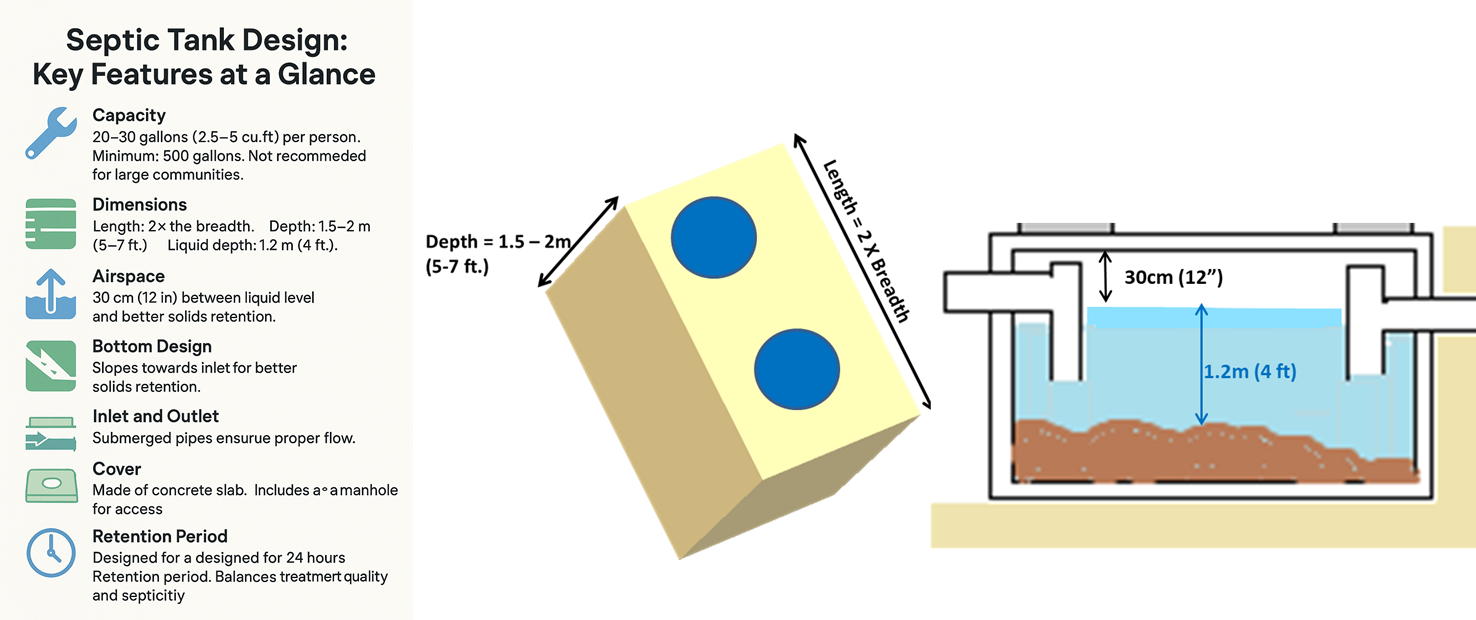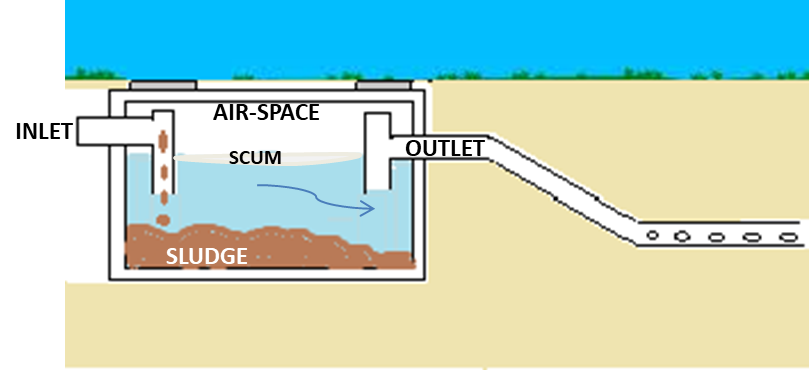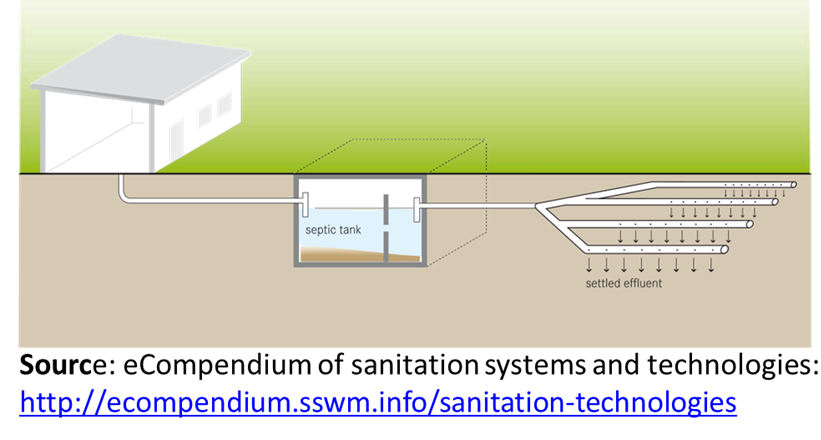A septic tank is an underground excreta (sewage) treatment system used in rural or suburban areas where there is no access to a centralized sewer system.
It’s a self-contained tank that collects and treats the human waste from one or more homes.
It is buried in the ground near the home/s. Think of it as the "middleman" between the excreta and the environment, filtering out harmful substances before the treated water is released back into the soil.
The tank is usually made of concrete, though fiberglass or plastic tanks are now available.
How Does a Septic Tank Work?
Septic tanks work through a natural process of settling, separating, and treating the waste. Here’s how it happens in simple terms:
1. Excreta and wastewater enter the tank: All the wastewater from the toilets of one or more houses flows into the septic tank through a pipe.
2. Separation of solids and liquids: Once inside the tank, the wastewater begins to separate.
• Heavier solids, in the waste, sink to the bottom, forming a heap of sludge.
• Lighter materials, like oils and grease, float to the top, forming a scum layer.
• The liquid layer in the middle is what we call effluent.
3. Bacterial breakdown: In the tank, naturally occurring bacteria break down the solid waste.
• Inside the tank, in dearth of oxygen, the solids are processed by the anaerobic bacteria and fungi.
• The solids are broken down into simpler chemical compounds.
• This is the first stage of purification called ‘Anaerobic digestion’
• This process drastically reduces the amount of solids and
• The solids are no more offensive in smell and sight
• Some gases (mainly CO2 and methane) are released in the process. These rise up as bubbles and accumulate in the air space
4. Effluent exit: The liquid ‘effluent’ escapes out from the tank through an outlet pipe
• Is allowed to percolate in the subsoil through a network of perforated pipes
• This network of pipes is buried in trenches 90 cm (3 ft) below the surface
• The aerobic bacteria in this soil, attack the organic matter present in the effluent
• The organic matter is oxidized into stable end products, i.e., nitrates, CO2 and water.
• This stage of purification is called ‘Aerobic oxidation’
• As the effluent slowly percolates through the soil, getting filtered naturally.
• By the time it reaches the groundwater, most of the harmful contaminants have been removed.
Summary: In a septic tank, sewage purification occurs in two key phases.
1. The initial phase involves anaerobic digestion, which happens inside the septic tank.
2. The second phase, aerobic oxidation, occurs outside the tank within the subsoil.
By combining these two processes, sewage undergoes complete treatment.
Operation and Maintenance of Septic Tanks
1. Avoid Harmful Chemicals
• Do not use soap water, disinfectants (like phenol), or harsh cleaning agents, as they can kill the beneficial bacteria in the tank.
• These anaerobic bacteria are essential for sewage breakdown.
2. Regular Sludge Removal
• Excessive sludge buildup reduces tank efficiency and capacity.
• De-sludging (removing sludge) should be done at least once a year.
• Dispose of the extracted sludge by trenching or other approved methods.
Critical Safety Reminder:
• Never enter the septic tank manually—toxic gases (e.g., methane, hydrogen sulfide) can be lethal.
• Use designated manholes for sludge extraction and dispose of waste safely (e.g., trenching or approved treatment).
3. Initial Seeding of New Septic Tanks
• Newly constructed septic tanks should first be filled with water up to the outlet level.
• Then, they must be seeded with mature sludge from an existing septic tank to introduce the necessary bacteria for effective decomposition.
The Double-Chambered Septic Tank
This design features two separate chambers inside the tank, which improves the efficiency of the wastewater treatment process.
1. In a double-chambered system, wastewater flows into the first chamber, where the majority of solid waste settles to the bottom.
2. The partially treated liquid then flows into the second chamber, where further settling occurs, and any remaining solids are allowed to break down more thoroughly.
This two-step process helps to ensure that the effluent leaving the tank is cleaner, reducing the chances of clogging the drain field or contaminating nearby groundwater.
The double-chamber design also extends the life of the system and requires less frequent pumping, making it a more efficient and reliable choice for homeowners with higher wastewater loads.
Why septic tanks are important?
While septic tanks may seem simple, they are critical for protecting both our health and the environment. Here's why:
• Wastewater treatment: Without a septic system, untreated wastewater could contaminate local water sources, leading to pollution and health hazards.
• Environmental protection: Septic tanks help protect the environment by ensuring that wastewater is properly treated before it enters the soil or groundwater. This reduces the risk of soil and water contamination from harmful bacteria and chemicals.
• Cost-effectiveness: For homes that are too far from a public sewer system, septic tanks provide an affordable alternative to expensive sewer connection fees.
• Self-sustainability: A properly maintained septic system is low-maintenance and lasts for many years, offering homeowners a reliable way to manage wastewater.
References:
• Guide 30, Developing Knowledge and Capacity in Water and Sanitation. WEDC website. Available from: https://wedc-knowledge.lboro.ac.uk/resources/booklets/G030-Septic-tank-a... Accessed on 29th April 2025.
• Park's Textbook of Preventive and Social Medicine. 26th ed. Jabalpur: M/S Banarsidas Bhanot; 2021. Environment and Health; p. 799-883.
• Park's Textbook of Preventive and Social Medicine. 27th ed. Jabalpur: M/S Banarsidas Bhanot; 2023. Environment and Health; p. 832-915.
• Bhalwar R. Textbook of Community Medicine. 5th ed. New Delhi: Wolters Kluwer; 2023. Chapter 8, Excreta Disposal; p. 89-101.
Sanitation Barrier: https://ihatepsm.com/blog/sanitation-barrier-keeping-our-communities-hea...
Excreta Disposal: https://ihatepsm.com/blog/proper-excreta-disposal-necessity-health-and-d...
Video on Sewage Treatment: https://youtu.be/M3iMq4-iFHg
Bore-Hole Latrine: https://ihatepsm.com/blog/bore-hole-latrine#google_vignette
The Dug Well Latrine (Pit Latrine): https://ihatepsm.com/blog/dug-well-latrine-pit-latrine-more-practical-al...
Borehole vs. Dug-Well Latrines: A Comparison: https://ihatepsm.com/blog/borehole-vs-dug-well-latrines-comparison
Water-seal Latrine: https://ihatepsm.com/blog/water-seal-latrine
RCA Latrine: https://ihatepsm.com/blog/rca-latrine
Septic Tank: How it Works: https://ihatepsm.com/blog/septic-tanks-how-do-these-work
Aqua Privy: https://ihatepsm.com/blog/aqua-privy-how-does-it-work
